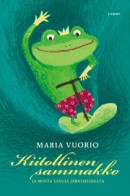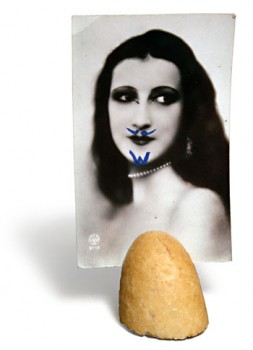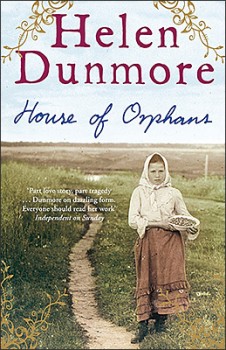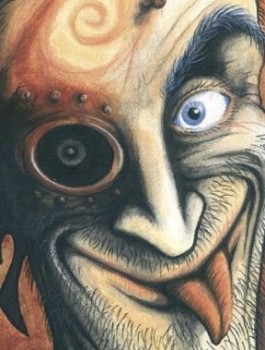Search results for "2010/02/2011/04/2009/10/writing-and-power"
Eino Leino Prize to Hannele Huovi
17 April 2009 | In the news

Hannele Huovi. - Photo: Laura Vesa
‘Methinks,/ said the sausage dog / who loved eating verse, that / poetry is tastier than bone.’ (From Karvakorvan runopurkki [Furry pooch’s jar of verse])
Hannele Huovi (born 1949) has received the 2009 Eino Leino Prize, worth € 5,200 and funded by the Finnish Book Foundation, for her extensive work as a writer of books for children and young people, of novels, poetry and text books. More…
Jukka Laajarinne: Ruoalla ei saa leikkiä [Don’t play with your food]
5 February 2010 | Mini reviews, Reviews
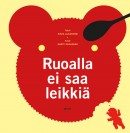 Ruoalla ei saa leikkiä
Ruoalla ei saa leikkiä
[Don’t play with your food]
Kuvitus [Ill. by]: Martti Ruokonen
Helsinki: WSOY, 2009. 60 p.
ISBN 978-951-0-35040-9
18.20 €, hardback
Jukka Laajarinne (born 1970) exercises his obsession with challenging authority again, stretching the boundaries of traditional children’s literature. It seems that becoming a father has made him wonder at the dominant role of food in everyday life: this book deals broadly with food, eating, and food culture. The impetus for the stories might be an ordinary figure of speech or adage that is taken apart and played with. For instance, King Midas, familiar from Greek mythology, who turned everything to gold with his touch, is transformed in Laajarinne’s retelling into a sticky-fingered kid who makes a mess of everything around him. Martti Ruokonen’s graphic illustrations are stark and even coarse in places, their colour choices and rounded forms reminiscent of visual images made for the first books for babies.
Lasse Rantanen & Hannu Tarmio: Lapin sydän [Heart of Lapland]
20 August 2010 | Mini reviews, Reviews
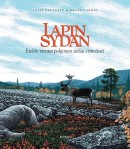 Lapin sydän. Etelän vieraat pohjoisen sielua etsimässä
Lapin sydän. Etelän vieraat pohjoisen sielua etsimässä
[Heart of Lapland. Visitors from the south in search of the Northern soul]
Helsinki: Nemo Publishing Company, 2009. 216 p., ill.
ISBN 978-952-240-015-4
€ 33, hardback
Lapland and its myths have always inspired artists and tourists. In this book two Lapland enthusiasts ponder the things that make Finns from the south return to the north over and over again. Former publisher Hannu Tarmio lost his heart to Lapland 60 years ago; Lasse Rantanen is a graphic designer who is building his own cabin in Savukoski, eastern Lapland. The book is illustrated with his ink-and-abrasive drawings. Tarmio discusses Sámi identity, the history of log floating and gold panning, river pearl mussel fishing, alcohol use, mythology, and tourism and its impact on the environment. The book contains excerpts from literature on Lapland and portraits of its authors (including Yrjö Kokko, Timo Mukka and Nils-Aslak Valkeapää) and presents indigenous Lapps – one of them was Aleksi Hihnavaara, nicknamed Mosku, a legendary but controversial reindeer herder and hunter who fought the Russian Skolt reindeer poachers.
Maria Vuorio: Kiitollinen sammakko [The grateful frog]
5 February 2010 | Mini reviews, Reviews
Kiitollinen sammakko ja muita satuja järviseudulta
[The grateful frog and other stories from the lake country]
Kuvitus [Ill. by]: Virpi Penna
Helsinki: Tammi, 2009. 111 p.
ISBN 978-951-31-5017-4
18.20 €, hardback
There is no need to categorise Maria Vuorio’s original yet tradition-conscious prose and poetry as being for readers of a particular age. A father and son, Aatos and Justus, are spending their vacation at a summer cabin. Justus rescues a frog from a well, setting in motion a chain of events that leads the boy to see the world through different eyes. The frog happens to be the king of the frogs, and wishes to reward Justus for his good deed. The stories are wonderful explorations of humble, reticent animals – a perch, a dragonfly, a spider, a crab, a mole. A bumblebee’s leg in a cast has probably never been described with such devotion before. Today, Finnish children’s relationship with nature is limited to the surroundings of the summer cabin. But Vuorio’s view of the relationship of child with nature is still a romantic one. Dazzled by the moonlight, Justus wonders to himself, ‘Why is there such beauty, if no one ever sees it?’
Paris, je t’aime
7 May 2010 | This 'n' that
‘Paris traverse la pensée comme une encyclopédie de la vie, où l’on découvre des passages, des cours intérieures, des ruelles et des autoroutes, toujours plus surprenants. La ville ne se vide ni n’abandonne jamais, n’accorde ni ne refuse.’
‘Paris permeates your mind like an encyclopaedia of life in which you will incessantly discover astonishing new passages, courtyards, alleys and avenues. It will never either run empty or surrender, it won’t admit or refuse.’
L’air de Paris / Pariisin tuoksu (‘Air of Paris’, Musta Taide, 2009) is an elegant little book that features artwork by Ismo Kajander and texts by Anna Kortelainen relating to the mother city of all artists. More…
Lauri Timonen: Lähikuvassa Matti Pellonpää [Matti Pellonpää in closeup]
16 July 2009 | Mini reviews, Reviews
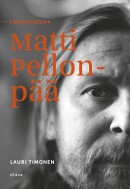 Lähikuvassa Matti Pellonpää
Lähikuvassa Matti Pellonpää
[Matti Pellonpää in close-up]
Helsinki: Otava, 2009. 335 p., ill.
ISBN 978-951-1-22903-2
€ 25, hardback
Matti Pellonpää (1951–1995) was one of the trusted actors, almost a trademark, of the film director Aki Kaurismäki. In 1993 he won the Felix Prize for best European male actor at the Berlin Film Festival for his role in La Vie de Bohéme. With his characteristic restrained empathy Pellonpää mostly played bohemians, unemployed people and outcasts. This portrait is built on the recollections of his friends and colleagues, as well as on the interviews by the author. These conversations deal with Pellonpää’s theatrical career and the musical experiments of his highly original band, Peltsix. The actor spent most of his free time in restaurants, where he eavesdropped on table talk and watched the eccentric personalities he encountered; the reader is also offered a sample of Pellonpää anecdotes.
Kirjailijoiden Kalevala [The writer’s Kalevala]
7 February 2014 | Mini reviews, Reviews
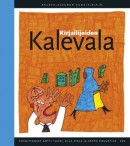 Kirjailijoiden Kalevala
Kirjailijoiden Kalevala
[The writer’s Kalevala]
Toim. [Ed. by]: Antti Tuuri, Ulla Piela ja Seppo Knuuttila
(Kalevalaseuran vuosikirja 92, the Kalevala Society’s yearbook 92)
Helsinki: Suomalaisen Kirjallisuuden Seura, 2013. 313 pp., ill.
ISBN 978-952-222-429-3
€47, hardback
The Kalevala is the Finnish national epic, compiled from oral folk poetry by Elias Lönnrot. It has provided a source of inspiration to Finnish culture since 1839. Kirjailijoiden Kalevala continues a project entitled ‘The artists’ Kalevala’, started in 2009. To start with, four scholars examine, from different viewpoints, the influence of folk poetry and the Kalevala on literature. Some twenty Finnish-language authors then approach the epic with original thoughts and literary means. The result may take the form of reminiscing, of a short story, poem or cartoon. In some texts the Kalevala is present only indirectly, in others some character of the epic is placed in the focus – Väinämöinen, Kullervo, Lemminkäinen or Aino. Kirjailijoiden Kalevala offers a multifaceted collection of viewpoints; aptly, the editors, in their foreword refer to the epic as a literary sampo, the mysterious, mythical object of the Kalevala that generates wealth and riches.
Marita Liulia: Choosing My Religion – Uskontoja jäljittämässä
30 July 2009 | Mini reviews, Reviews
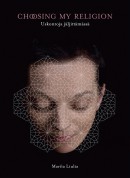 Choosing my Religion – Uskontoja jäljittämässä
Choosing my Religion – Uskontoja jäljittämässä
Käännökset englanniksi [English translations]: Michael Garner
Helsinki: Maahenki, 2009. 223 p., ill.
ISBN 978-952-5652-61-1
€ 38, hardback
Marita Liulia is a visual artist who specialises in interactive media art. Her works have been shown in more than 40 countries. Choosing my Religion discusses the nine major religions of the world. It contains 150 pictures and photographs, as well as texts by the artist and an article by associate professor of comparative religion Terhi Utriainen. The book, like the exhibition at Helsinki’s Kiasma museum which it accompanies, focuses on the religions and on animism. Liulia has travelled in 50 countries, studying religions and discussing them with both scholars and laymen. Her project concentrates on the possibilities of equal choice between religions and emphasises their positive aspects. The subject of the photographs in the book is the artist herself, who abandoned her Christian faith as a teenager. As a child she suffered from rheumatoid arthritis, and was unable to walk until she was 15. Liulia has portrayed herself in the traditional dress and emblems of the different faiths. In her view one of the features uniting all religions is the fact that in them women play the role of servants who pass on the faith to succeeding generations. Choosing my Religion comprises the book, the (touring) exhibition and a website.
Stories in stone
9 November 2012 | This 'n' that
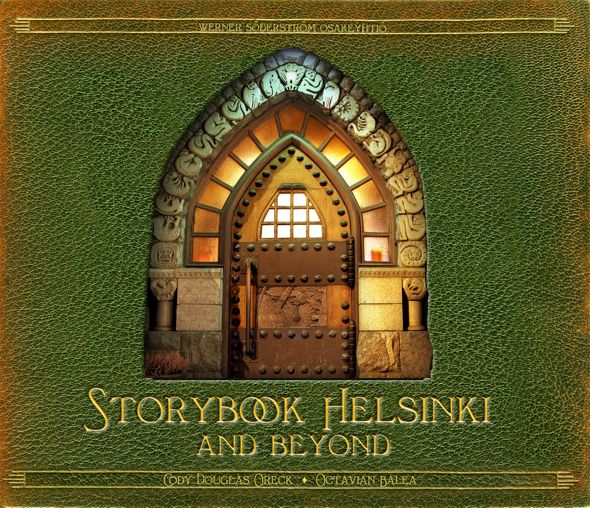 Birds and bees, frogs, squirrels, water lilies, thistles, ferns, junipers, bears and even gnomes originating in Finnish nature appear, in abundance, in Finnish architecture of the two decades around the turn of the 20th century.
Birds and bees, frogs, squirrels, water lilies, thistles, ferns, junipers, bears and even gnomes originating in Finnish nature appear, in abundance, in Finnish architecture of the two decades around the turn of the 20th century.
The trend that developed out of the Arts and Crafts Movement in Great Britain and in the United States, known as l’art nouveau in France and Jugendstil in Germany, lived a short but extremely fervent life in Finland, which adopted the term jugend.
In Finland this aesthetic movement is also called national romanticism. In 1899 the pan-Slavic movement arising in Russia took the form of attempts to suppress Finland’s burgeoning national identity in Finland, and in resisting this, artists made extensive use of national romantic material in their work. More…
Finland, cool! The Frankfurt Book Fair 8–12 October
30 September 2014 | Articles, Non-fiction

Finnland. Cool. pavilion in Frankfurt, designed by Natalia Baczynska Kimberley, Nina Kosonen and Matti Mikkilä from Aalto University
It starts next week: Finland is Guest of Honour at the Book Fair in the German and global city of Frankfurt. This link will take you to it all.
Approximately 170,000 professionals from the literary world are expected to visit the exhibition halls from Wednesday to Friday; the weekend is reserved for the general public, c.100,000 visitors. Since 1980s different countries have been in focus each year. More…
Kaiken takana oli pelko. Kuinka Viro menetti historiansa ja kuinka se saadaan takaisin [Fear behind it all. How Estonia lost its history and how it will be recovered]
23 July 2009 | Mini reviews, Reviews
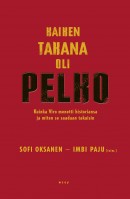 Kaiken takana oli pelko. Kuinka Viro menetti historiansa ja kuinka se saadaan takaisin
Kaiken takana oli pelko. Kuinka Viro menetti historiansa ja kuinka se saadaan takaisin
[Fear behind it all. How Estonia lost its history and how to get it back]
Toim. [Ed. by] Sofi Oksanen & Imbi Paju
Helsinki: WSOY, 2009. 563 p., ill.
ISBN 978-951-0-35111-6
€ 29, hardback
Twentieth-century Estonian history was marked by a brief German occupation (1918) and a Soviet occupation lasting nearly half a century (1940–1991). This book contains more than 30 articles by Finnish, Estonian, Russian, British and American experts in the field, dealing with with subjects that include the propaganda of the Soviet occupation, the methods of political oppression, environmental pollution, corruption and the situation of the arts and culture during the occupation. There are also previously suppressed memoirs and reminiscences by survivors of the Gulag prison camps. Sofi Oksanen (born 1977) is a Finnish writer of Estonian heritage who was awarded the 2008 Finlandia Prize for Fiction for her novel Puhdistus (‘Purge’), which is based on Estonian history. Imbi Paju (born 1959) is an Estonian film director and writer. The book deals with the morality of a totalitarian state in general, and examines how different contries have approached the concept of human rights violations in recent times. It has given rise to much debate about Finland’s relations with neighbouring Estonia and its people.
Johanna Holmström: Asfältsänglar [Asphalt angels]
21 March 2013 | Mini reviews, Reviews
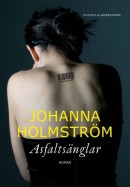 Asfältsänglar
Asfältsänglar
[Asphalt angels]
Helsinki: Schildts & Söderströms, 2012. 294p.
ISBN 978-951-52-3120-8
€29.90, hardback
Finnish translation:
Itämaa
Helsinki: Otava, 2012. 333 p.
Suom. [Translated by] Tuula Kojo
ISBN 978-951-1-26841-3
€29.90, hardback
The immigrant novel has not played a significant role in contemporary Finnish literature; since the wave of Russian refugees in the early 19th century, there have been few immigrants to Finland. In her short story collection Camera Obscura (2009) Johanna Holmström (born 1981) managed to combine realism and fantasy in a fascinating way; her new novel, Asfaltsänglar, is the directly yet eloquently told story of two young immigrant sisters. Leila, bullied at school, is becoming a drop-out, while Samira, who has tried to live according to western norms, lies unconscious after an unexplained accident. Their Finnish mother is a fanatical convert to Islam and their father comes from the Maghreb region. The novel confronts claustrophobic Arabic family culture and western ideals of freedom, taken so far that people completely lose any sense of responsibility for one another, with the adults’ betrayal of their children playing a key role. Holmström goes to great lengths to give a balanced portrayal of both cultures and show why her characters act as they do, even when the results are tragic.
Translated by Claire Dickenson
Positive fools
1 April 2010 | This 'n' that
‘People who think about what others think of them are above all afraid of being ridiculed. Consider it an irony of fate or not, but the Finns in literature are usually laughable in some way or other,’ Janna Kantola – lecturer in Comparative Literature in Helsinki University – writes in an article entitled ‘Strong, thirsty and weird’, published in the 6/2009 issue of the Helsinki University Bulletin.
Mostly they drink and end up on the wrong side of the law. For example, there are Finnish seafarers in fiction by European writers whose rum bottles apparently have no bottoms.
‘Finland and the Finns appear, in particular, in thrillers from the Cold War: from Raymond Chandler’s The Long Goodbye (1953) to Alistair MacLean’s novel HMS Ulysses (1955). In these works, the unsmiling and hulking Finns have wide, horny hands, massive bottoms and the strength of a hundred men.
‘But not to worry. On a couple of occasions, Finns have even got to be the main characters of books. In these instances, the Finns no longer make people laugh but are mostly tragic, just as the characters in literature usually are when they are most interesting.
‘The main character in Richard Rayner’s novel The Cloud Sketcher (2000, USA) is an architect – a popular profession for Finns in modern literature – who has a disfigured face and a hard history, reaching America by way of the Finnish civil war. The historical novel by Helen Dunmore, House of Orphans (2006, UK), set in Finland in 1901–1904, is a love story about two young rebels, Eeva and Lauri.
One of the success stories of Finnish literature abroad are the humorous novels by Arto Paasilinna (born 1942): they have been translated into almost 40 languages. ‘Through his books Arto Paasilinna has turned being a fool into a positive characteristic. All things considered, this is something Finland will have no shortage in offering,’ Kantola concludes.
The legacy of a self-made man
29 October 2010 | This 'n' that
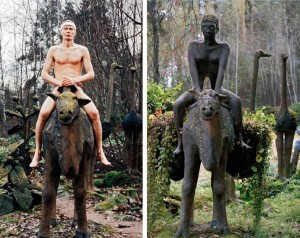
On camelback: in the exotic part of Veijo Rönkkönen’s concrete cosmos there are animals and palm trees, side by side with the living plants of the northerly latitudes. - Photo, left: Veijo Rönkkönen; photo, right: Veli Granö
Some of our readers may remember a story entitled ‘Self-made man’, published in Books from Finland in April 2009: Veijo Rönkkönen, who lived his entire life on a small, isolated farm in eastern Finland, built a garden inhabited by five hundred human and animal figures made of concrete.
Rönkkönen worked in a nearby pulp factory for 41 years. He lived in a small house in the middle of the garden, surrounded by his sculptures, which he had started making in the early 1960s.
Photographer and writer Veli Granö introduced the life and works of this self-made artist in his book Veijo Rönkkösen todellinen elämä / The real life of Veijo Rönkkönen (text in Finnish and English, Maahenki, 2007).
Contemporary folk art in Finland goes by the acronym ITE, from the words itse tehty elämä, ‘self-made life’. The French called it art brut; the English-language term is ‘outsider art’. The artists are ‘unschooled visionaries’ who make their art independent on any societal requirements or definitions.
The sculpture park became the most notable tourist attraction in Parikkala, visited by as many as 26,000 visitors every summer. Rönkkönen, however, refused to turn it into business. He never talked to visitors voluntarily either, but the park was open and free to all. He was awarded a state prize for artistic achievement, the Finland Prize, worth €30,000, in 2007, which he accepted.
Veijo Rönkkönen died last spring at the age of 66. The estate – Rönkkönen’s siblings, living elsewhere in Finland – offered the unique park to the county of Parikkala, which declined the offer because it’s upkeep was estimated to be too expensive.
In October businessman Reino Uusitalo bought the place for €140,000, with the intention of founding an administrative committee for the upkeep of the park. Rönkkönen’s extraordinary ‘total work of art’, will thus stay open – at least until nature – lichen, moss, creepers – claims what it considers it own. 500 sculptures: a self-made man’s open-air art
Child of chaos
10 September 2010 | Comics, Fiction
A cornucopia of exciting plots and strange characters, the mythic epic Kalevala has inspired innumerable artists since its first publication in the 1830s. A recent interpretation of the story of an extremely tragic hero named Kullervo takes the form of a graphic novel by Gene Kurkijärvi: his urban Kullervo lives in a grim environment – not unlike Helsinki, but carrying with dystopian overtones – where the heroes and/or villains are steely androids and hairy weirdos who shoot drugs and use foul language. This 21st-century Kullervo is a surrealist cyberpunk tragedy – laced with pitch-black comedy.
Extracts from the graphic novel Kullervo by Gene Kurkijärvi (Like, 2009; captions translated by Owen Witesman) More…

